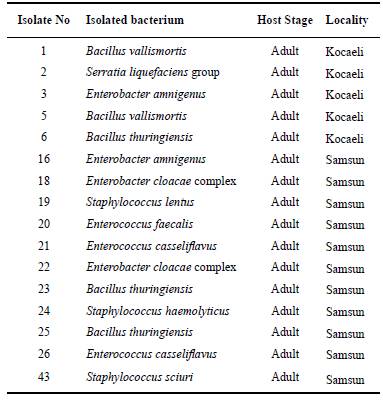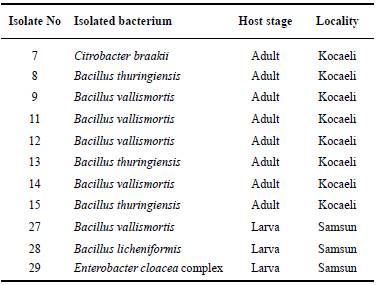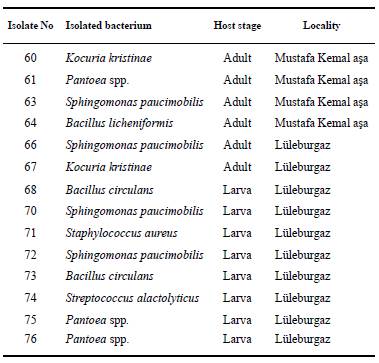Introduction
Poplars play a significant role in afforestation and reforestation, rehabilitation of degraded forests and fragile ecosystems; enhance the contribution of forests and trees in mitigating the effects of climate change; reverse the loss of natural forests and ensure the restoration of landscapes (FAO 2009). The adults and larvae of several poplar pests feed on roots, trunks and leaves. Authorities have been trying to control these pests using chemical insecticides. Chemical control is the most widely known suppressive method, but has many undesirable effects on the natural and beneficial animals, plants and other elements of the environment. Therefore, this method should be discontinued in urban forests (de Tillesse et al. 2007). On the other hand, entomopathogenic organisms are safe, sustainable and environmental-friendly control agents and they are highly host-specific; thus, other biotic and abiotic elements of the environment are unharmed (Ya- man 2003; Contarini et al. 2013; Ruiu et al. 2013; Sabino et al. 2015). There are only a very few studies (Sidor and Jodal 1986; Vriesen and Keller 1994) that have explored the ento- mopathogenic organisms which can be used as control agents against poplar pests. Furthermore, there isn’t any study on the entomopathogenic bacteria of some important poplar pests such as Sciapteron tabaniformis (Rottemburg, 1775) (Lepidoptera: Sesiidae), Nycteola asiatica (Krulikovsky, 1904) (Lepidoptera: Nolidae) and Cryptorhynchus lapathi Linnaeus, 1758 (Coleoptera: Curculionidae). In this study, we aimed at investigating the entomopathogenic bacteria of four important poplar pests: Cryptorhynchus lapathi L. (Coleoptera: Curculionidae), S. tabaniformis Rott. (Lepidoptera: Sesiidae), N. asiatica (Lepidoptera: Nolidae) and Gypsonoma dealbana (Frolich, 1828) (Lepidoptera: Tortricidae).
The purpose of this study is to reduce the economic burden caused by poplar pests on the poplar breeding industry and also propose alternative ecological control agents against important poplar pests by decreasing the undesirable effects caused by chemical pesticides in urban areas and urban forests.
Material and methods
Insect samples.
In this study, the larvae and adults of four important poplar pests, which were C. lapathi L. (Coleoptera: Curculionidae), S. tabaniformis Rott. (Lepidoptera: Sesiidae), N. asiatica (Lepidoptera: Nolidae) and G. dealbana (Lepidoptera: Tortricidae), were collected from five different localities in Turkey from April to September 2013.
Isolation and identification of bacteria from insect pests.
After macroscopic observations, dead and living larvae and adults exhibiting characteristic disease symptoms such as no feeding, slow mowing and colour changes on the body were selected for bacterial isolation. The larvae and adults were individually placed into 70 % ethanol and gently shaken for 3 min and then washed tree times with distilled water for surface sterilization (Kuzina et al. 2001; Yaman et al. 2002). After surface sterilization, the insects were dissected in sterilized distilled water depending on the their body size to avoid any damage in their guts. A drop of hemolymph was taken from the dissected insect, diluted 100 times with sterile water and spread on nutrient agar plates. The plates were incubated at 25-36 °C for 24-48 h. After incubation, the plates were examined and bacterial colonies were selected (Thiery and Frachon 1997). The selected colonies were purified by subculturing on plates. Different colony types of bacteria were selected and purified on nutrient agar plates by subculturing. Individual colonies were subcultured twice to ensure purity (Kuzina et al. 2001). Bacterial strains were preserved for long-term storage in nutrient broth with 15 % glycerol at -86 °C for further tests. The isolates were stored at the Department of Biology, Faculty of Science, Karadeniz Technical University.
All bacterial isolates were initially stained by Gram’s dye for the identification of Gram-positive or Gram-negative bacteria and tested for some biochemical reactions. Then, VITEK bacterial identification systems (bioMerieux, Prod. No; 21341 and 21342) were used for the identification of the isolated bacteria. Additionally, Bacillus species were stained to reveal the presence of crystal protein (Sharif and Alaed- dinoglu 1988).
Results and discussion
In the present study we isolated forty-three bacteria from the larvae and adults of four important poplar pests, which were C. lapathi (Coleoptera: Curculionidae), S. tabaniformis (Lepidoptera: Sesiidae), Nycteola asiatica (Lepidoptera: Nolidae) and G. dealbana (Lepidoptera: Tortricidae), in five different localities (Tables 1, 2, 3 and 4). The members of the genera from the Bacillaceae and Enterobacteriaceae families were isolated most commonly from both pest insects. It is known that these families include entomopathogenic bacterial species while several species isolated from the insects were found to be pathogenic and tested as biological control agents against insects (Kuzina et al. 2001; Yaman 2003; Yaman et al. 2002, 2010; Aslan et al. 2005; Ertürk et al. 2008).
There isn’t any study conducted on bacterial pathogens for biological control of C. lapathi. In total, sixteen bacteria were isolated from C. lapathi L. (Coleoptera: Curculionidae). These bacteria were classified in five different genera: Bacillus, Enterobacter, Serratia, Enterococcus and Staphylococcus. The isolated bacteria were identified as the members of ten different species, and the species from two different localities that were far from one another had similarities (Table 1). Bacillus thuringiensis, Bacillus vallismortis, Enterobac- ter amnigeneus and Enterobacter cloacae were observed to be the most common species of C. lapathi. Serratia liquefa- ciens was isolated once. B. thuringiensis and E. amnigeneus were isolated from both populations (Kocaeli and Samsun) of C. lapathi, which were far from one another. Most of the Bacillus species are insect pathogens and have different insecticidal effects (Yaman and Demirbag 2000; Ertürk et al. 2008). Yaman et al. (2010) isolated Entorebacter amnigenus from the bark beetle Dendroctonus micans and found it to be pathogenic on this pest with a rate of 72.2 % on the larvae and 37.5 % on the adults. One of our isolates from C. lapathi was Serratia liquefaciens. Some insect pathogenic species of the genus Serratia have been isolated from different insects (Ya- man et al. 2010) and would possibly be the bio-control agents against some insects (Sezen et al. 2001). S. marcescens is one of the best-known and pathogenic species (Thiery and Fra- chon 1997). C. lapathi is one of the most destructive poplar pests. In the literature, there isn’t any study on the bacterial flora of C. lapathi. In this study, all bacteria were isolated and identified from C. lapathi for the first time.
The second poplar pest investigated in this study was S. tabaniformis (Lepidoptera: Sesiidae). Eleven bacteria were isolated from the larvae and adults of this pest. These bacteria were classified in three different genera: Bacillus, Enterobacter and Citrobacter The isolated bacteria were identified as the members of five different species, and one species from two different localities was the same in both larvae and adult (Table 2). The members of the genus Bacillus were most commonly seen in S. tabaniformis populations. Most of the Bacillus species are insect pathogens and have different insecticidal effects (Thiery and Frachon 1997; Ertürk et al. 2008; Ruiu et al. 2013). Twenty-two Bacillus species that are most frequently found in nature are well- identified and recognized worldwide (Thiery and Frachon 1997).
Another poplar pest investigated in this study was Nycteola asiatica (Lepidoptera: Nolidae). Fourteen bacteria, six from the adults and eight from the larvae, were isolated from N. asiatica. These bacteria were identified as the members of seven different species from six different genera: Bacillus, Kocuria, Pantoea, Streptococcus and Staphylococcus. Two species from two different localities was the same in both larvae and adult (Table 3). The results showed that bacterial flora of N. asiatica consisted of the species from several different genera. Pantoea spp., Bacillus licheniformis and B. circulans, identified from this pestare known to be insect pathogens (Thiery and Frachon 1997; Yaman et al. 2010).
Another lepidopteran poplar pest examined in this study was Gypsonoma dealbana (Lepidoptera: Tortricidae). Two bacteria were isolated from the larvae from G. dealbana collected from two different localities (Table 4). Both isolates belonged to the genus Pantoea; Pantoea spp. and Pantoea agglomerans.Yaman et al. (2010) found this bacterium to be pathogenic for D. micans with a rate of 86 % on the larvae and 44.4 % on the adults.
In this extensive study, a total of forty-three bacteria were isolated from the larvae and adults of four important poplar pests, which were Cryptorhynchus lapathi L. (Coleoptera: Curculionidae), Sciapteron tabaniformis Rott. (Lepidoptera: Sesiidae), Nycteola asiatica (Lepidoptera: Nolidae) and Gypsonoma dealbana (Lepidoptera: Tortricidae), from six different localities in Turkey. All bacteria were isolated and identified from these pests for the first time, and this study is the first bacteriological study on the biological control of three important poplar pests, that are C. lapathi, S. tabaniformis and N. asiatica. Nineteen bacterial isolates out of 43 were different species. As presented in Tables 1, 2, 3 and 4; the bacterial flora of the important poplar pests has very rich species diversity. Fortunately, some other plant pests (Yaman and Demirbag 2000) such as Bacillus spp. have also been frequently isolated from poplar pests; furthermore, Bacillus thuringiensis was the most common bacterium among the isolated bacteria in the present study. Several species of Bacillus are insect pathogens and they have different insecticidal effects on insect pests (Yaman and Demirbag 2000; Yaman et al. 2002; Ertürk et al. 2008; Ruiu et al. 2013). As shown in tables 1, 2 and 3; this study confirms that poplar pests have a rich diversity in Bacillus. On the other hand, Entorebacter amnigenus, Serratia liquefaciens and Pantea aglomerans isolated and identified from poplar pests in this study also have a potential insecticidal effect on insect pests. These bacteria have a very high pathogenicity against plant pests. Moreover, some bacteria produce chitinase enzyme that degrades chitin, a structural polysaccharide in insects (Zhang et al. 2002). The chitinase activity among bacteria has been recorded maximally in the members of the genera Streptomyces, Serratia, Vibrio and Bacillus, while this enzyme is of great importance for the suppression of pest insect populations (Reguera and Leschine 2001). The members of the genera Serratia and Bacillus were the most commonly found bacteria in poplar pests in the present study.


















